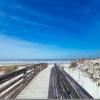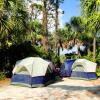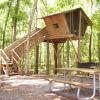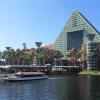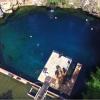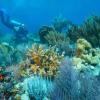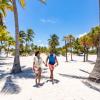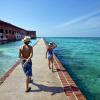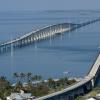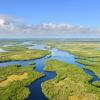The “Tour to Land’s End” isn’t yet complete. But even a partial passage to one of Florida's undiscovered cycling trails is more than worthwhile.
By Herb Hiller
Today, completed sections of the Florida Keys Overseas Heritage Trail chiefly attract locals with shopping baskets on fat-tire bikes they pedal to nearby food markets and laundromats. But by mid-decade, when the trail may be 95 percent paved and off-road, it will roll out the biggest getting-around improvement for visitors biking the Florida Keys since road replaced rail after the Labor Day Hurricane of 1935.
The 106-mile trail will link Key Largo with Key West across 37 bridges, many off-limits to cars, and where the rarely absent tailwind wraps around bare arms and legs just as it churns blue water below.
I had my own wild moment during the four days when a friend named Ted and I recently cycled along part of the route. We crossed the Seven Mile Bridge on the paved shoulder exposed to crosswinds. We hugged the low barrier away from cars, where I imagined a wind gust blowing us, bikes and backpacks to the bottom. I walked the bike up the hump of the bridge that allows high-masted boats to pass beneath. On the way down I flew. The wind blew. I squeezed my brakes.
Everywhere beauty and caution contrast the ride. Strong cyclists can handle it in two days, paved and unpaved sections alike, riding the often narrow shoulders. Count on at least three days for the rest of us.
The route for biking the Florida Keys varies. Long in-place sections carry you through Key Largo, Islamorada and Marathon – 47 miles on these sections alone. But there’s trail and there’s trail. Toward Tavernier where trees supply shade, roots buckle the pavement.
Some of the best sections of the Florida Keys Overseas Heritage Trail include a canopied three-mile neighborhood road through Islamorada that joggers and walkers also use; and for five miles starting at the retrofitted historic rail bridge across Tom’s Harbor Cut, the ride mostly avoids sight and sound of the highway, channeled by a screen of roadside buttonwoods and mangroves to the bay.
You grasp how the entirely finished trail will favor the continuing comeback of bikes from when cycling was fresh and so were the bridges built by an aged Henry Flagler for his “Railroad that Went to Sea.”
Now the compulsion that drove Flagler drives cyclists.

When complete, the 107-mile trail will link Key Largo with Key West across 37 bridges.
- Patrick Farrell for VISIT FLORIDA
From a car, the road through built-up areas is often crowded, often just two lanes filled with motorists itchy to get around local traffic. You stop for a restaurant, maybe a motel overnight, a sandals outlet or crafts shop.
Although today’s mile markers are made of green metal, people in cars passing a thrift store on Big Pine Key likely won’t see the last remaining mile marker, still in its low place from railroad days, a relic stone that reads “492 JAX” on one side “30 KW” on the other. Look for it as you pedal by.
Likely also missed at the ranger station of Long Key State Park is a rusted section of track used by trollies that carried luggage from the rail line to the site of the Long Key Fish Camp. Western writer Zane Grey fished here with Flagler’s pampered swells. That was a fab Florida getaway.
Driving, you won’t miss the bizarre logo eye at Baby’s Coffee on Saddlebunch Keys, but chance might deny you a close-up of a great white egret with yellow beak and eyes painted mascara blue-green. And you will miss the chain-link bike parking rack that seems to defy gravity along the Grassy Key Trail where a dirt path slips to the bay.
In cars you stop for gas. On bike, you stop anywhere to avoid saddle soreness.
One lucky stop was at an Islamorada parking lot backed by a billboard-sized mural of the first train crossing the Long Key Viaduct. On a blowy night, car lamps illuminate Flagler's sophisticates at their dressy leisure. Outside, a beam searches the way forward and the steamy hiss of brakes prepares a stop over stormy waters. Flagler himself, with a Mona Lisa smile, shines down as the man in the moon.

A man rides his bike along the Florida Keys Overseas Heritage Trail past some lobster traps on Lower Matecumbe Key.
- Patrick Farrell for VISIT FLORIDA
At the end of a day biking the Florida Keys, Ted and I avoided riding or walking to dinner in the dark. We ate early one evening at a waterfront place in Tavernier. We arrived early enough to score $28 fresh fish dinners and two-for-one beer and wine. A guitarist under a boat top covered Buffett songs. At the deck, bar tourists were getting high. Paradise.
I didn’t feel it. Expedition mode possessed me. We had packed next to nothing. We washed clothes every night. Once, after 45 miles, I slept for 12 hours. You do wonder what’s the point of four days for what you can otherwise drive in a scant three hours. Yes, the exploration, but even four days isn’t long enough, fancies Department of Environmental Protection Trail Specialist Monica Woll.
Woll calls four days “ridiculously fast. Slow down. Take two weeks. Get to the beach.” (Although Florida Keys beaches are few.) She recommends a walk to the Flagler-era work camp on Pigeon Key that’s at the end of a two-mile lopped-off bridge (no cars allowed). She prefers calm days, when you can see sharks, manta rays, and turtles in clear water below. I’ll add to Pigeon Key the mile and a half ride west out of Big Pine Key to the No Name Pub that opened a year after the killer hurricane of ’35 -- woody, funky and dim as ever, dollar bills pasted all around like wingy, stingy things on fly paper.
You enter Key West, exultant along the trail, through the hugger-mugger of New Town. I prefer this option to riding the mile-longer beachside trail, precisely for its urban clash after the last stretch of boring shoulder. Here, instead one finds the din of supermarkets, pizza joints, jet ski rentals, chain hotels. “Pity the drudges, ” I say to myself, imagining my arms thrust high in a triumphant breasting of the Tour de France finish line. Yes, me who won’t dare take his hands off the bars for anything!
You’re pumped for Old Town -- Toon Town -- beyond the reach of fast cars. Instead, cars so slow that on a narrow, clogged street a cyclist wearing a parrot on his shoulder calls to a motorist “Get a bike!” We lock ours, ready to party.
NOTE: The ride down is unequaled. The ride back is either all the way into the wind or by Greyhound that requires you to box the bikes; two to Miami International Airport for about $230. You can rent a minivan for about $150, including gas. Easy choice.
For information about the Florida Keys Overseas Heritage Trail including maps see https://www.floridastateparks.org/trail/Florida-Keys.

A couple rides their bikes on the old 7-mile bridge along the Florida Keys Overseas Heritage Trail.
- Patrick Farrell for VISIT FLORIDA
PLACES TO REMEMBER
RELATED CONTENT
Great Hiking Trails in Florida
- 10 minute read
By Lauren Tjaden With varied terrain and tremendous ecological diversity, Florida provides hikers of every skill level a perfect backdrop for exercise...
10 Florida Trails You Need to Experience
- 5 minute read
Want to experience the splendor of greenways and trails? Florida's your place. Outdoor enthusiasts are encouraged to step off of the beaten path...
Where and How to Meet Dolphins in Florida
- 11 minute read
Except perhaps for alligators, few animals are associated more with Florida than the dolphin. Here's where to see, feed, touch, paint with,...

